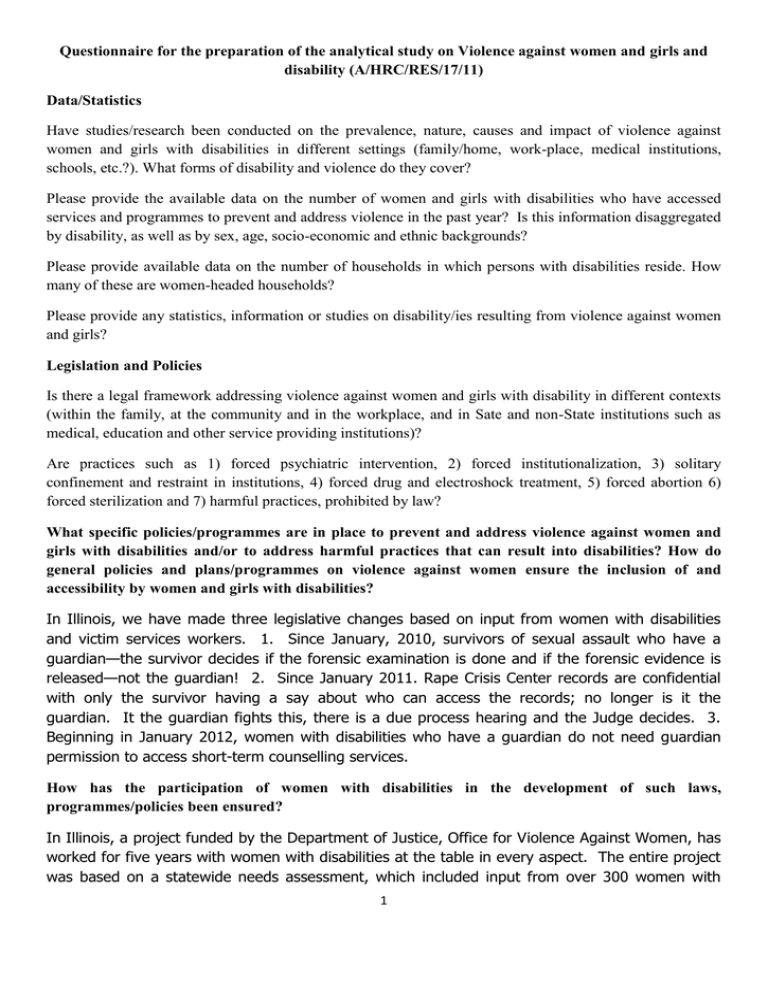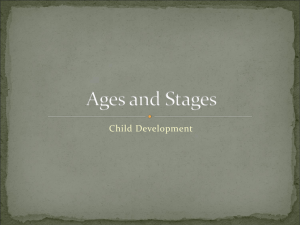
Questionnaire for the preparation of the analytical study on Violence against women and girls and
disability (A/HRC/RES/17/11)
Data/Statistics
Have studies/research been conducted on the prevalence, nature, causes and impact of violence against
women and girls with disabilities in different settings (family/home, work-place, medical institutions,
schools, etc.?). What forms of disability and violence do they cover?
Please provide the available data on the number of women and girls with disabilities who have accessed
services and programmes to prevent and address violence in the past year? Is this information disaggregated
by disability, as well as by sex, age, socio-economic and ethnic backgrounds?
Please provide available data on the number of households in which persons with disabilities reside. How
many of these are women-headed households?
Please provide any statistics, information or studies on disability/ies resulting from violence against women
and girls?
Legislation and Policies
Is there a legal framework addressing violence against women and girls with disability in different contexts
(within the family, at the community and in the workplace, and in Sate and non-State institutions such as
medical, education and other service providing institutions)?
Are practices such as 1) forced psychiatric intervention, 2) forced institutionalization, 3) solitary
confinement and restraint in institutions, 4) forced drug and electroshock treatment, 5) forced abortion 6)
forced sterilization and 7) harmful practices, prohibited by law?
What specific policies/programmes are in place to prevent and address violence against women and
girls with disabilities and/or to address harmful practices that can result into disabilities? How do
general policies and plans/programmes on violence against women ensure the inclusion of and
accessibility by women and girls with disabilities?
In Illinois, we have made three legislative changes based on input from women with disabilities
and victim services workers. 1. Since January, 2010, survivors of sexual assault who have a
guardian—the survivor decides if the forensic examination is done and if the forensic evidence is
released—not the guardian! 2. Since January 2011. Rape Crisis Center records are confidential
with only the survivor having a say about who can access the records; no longer is it the
guardian. It the guardian fights this, there is a due process hearing and the Judge decides. 3.
Beginning in January 2012, women with disabilities who have a guardian do not need guardian
permission to access short-term counselling services.
How has the participation of women with disabilities in the development of such laws,
programmes/policies been ensured?
In Illinois, a project funded by the Department of Justice, Office for Violence Against Women, has
worked for five years with women with disabilities at the table in every aspect. The entire project
was based on a statewide needs assessment, which included input from over 300 women with
1
disabilities. Illinois Imagines has established 32 collaborative teams across the state. Each team
includes women with disabilities, Rape Crisis Center(s), and a variety of disability organizations.
The teams develop a charter and a strategic plan to take steps to address best practices response
to women with disabilities who experience sexual violence. Each community also has teams which
include women with disabilities and an educator form the Rape Crisis Center that were recently
trained to co-teach classes to women with disabilities about sexual violence prevention, healthy
relationships and human sexuality. Women with disabilities have leadership roles in the
collaborative teams as well as in the Public Policy committee which has a blueprint for change and
has made four legislative changes which give more power to victims with disabilities who
experience sexual violence.
Prevention and Protection
What measures/initiatives are in place to combat negative perceptions, stereotyping and prejudices of
women and girls with disabilities in the public and private spheres?
Several self-advocacy initiatives are in place which combat the stereotyping of women and girls
with disabilities. There are several curricula being taught which also combat these negative
perceptions. Illinois and a few other states have a Disability History and Awareness Law that
requires the teaching about people with disabilities in public schools.
What initiatives exist to inform women and girls with disabilities about their rights, including sexual
and reproductive health issues? To what extent do these initiatives address also women in
institutions?
In Illinois, a curricula has been developed and distributed statewide to each Rape Crisis Center, to
many disability organizations, and to many women with disabilities. Teams have been trained
across the state to teach the curriculum which includes healthy relationships, human sexuality and
sexual violence prevention. At this time, it is limited to women living in the community with plans
to include women in Institutions in the future. In 2000-2004, a model sexual abuse prevention
curriculum for people with developmental disabilities was tested in 6 counties in Illinois. Since
that time, the WE CAN Stop Abuse Curriculum has been taught in several states, as well as in
Australia.
What programmes/initiatives have been developed to train women with disabilities to develop skills
and abilities for economic autonomy and participation in society and to use technological and other
aid that lead to greater independence?
Inthe US, several Vocational Rehabilitation programs exist to teach women with disabilities skills
and also to obtain employment, with the goal of economic self-sufficiency.
What measures exist to ensure access by women and girls with disabilities to social protection programmes
and poverty reduction programmes?
Please provide information on other measures (legislative, administrative, juridical or other) aimed at
the development, advancement and empowerment of women with disabilities
2
Self-advocacy movement...varies by state but in general works to advance issues relevant to
people with disabilities. Local groups and statewide organizations are run by and for people with
disabilities.
Are there provisions for regular home visits and inspections of medical institutions where women and girls
with disabilities are living/receiving treatment? How do these work?
What measures have been adopted to provide information and education to women and girls with
disability and their families, caregivers and health providers on how to avoid, recognize and report
instances of exploitation, violence and abuse?
Again, I speak most confidently about Illinois. There are laws about mandated reporting for
suspicions of abuse of persons with disabilities. These laws include mandated training for
employees of organizations that receive public funds to operate. It is common knowledge among
employees of these organizations, what is to be reported and within what timeframes. Staff are
trained on a regular basis. Each state has its own set of laws. However, the laws do not
necessarily include the training of people with disabilities; some include an annual review of
individual rights with each person receiving services. I consider this very different than training.
What are the means to report violence against women and girls with disabilities in different settings,
including medical centres and institutions? To what extent are these known and accessible?
There are toll free hotline numbers to report violence against women with disabilities who receive
services from organizations that receive public funds. The numbers are known to employees
more than to the women. The numbers are posted in some locations. Some people receiving
services do not have private access to a phone and might not feel safe to report by phone.
To what extent are public institutions, such as police stations and hospitals, accessible to women and
girls with disabilities?
Varies significantly by jurisdiction.
Are there shelters for women victims of violence? To what extent are they physically accessible to
women with disabilities?
Yes, there are shelters for victims of violence. Some are physically accessible and some are not.
Prosecution and Punishment
Are there disaggregated statistics on crimes against persons with disabilities?
US Bureau of Justice Statistics began measuring this in 2007. Two annual reports have been
released to date.
Please provide information on the total amount of registered complaints for violence against women and
girls with disabilities? Of the total amount how many were dismissed? What were the main reasons for
dismissal? Of the cases that were prosecuted, how many resulted in convictions?
3
What system is in place to ensure legal aid for women and girls with disabilities who have been victims of
violence?
What special measures have been envisaged in legislation and practice for victims and witnesses with
disabilities?
What specific training is conducted for law enforcement and legal personnel on the rights of women
and girls with disabilities and effective ways to communicate with them?
This varies a lot across the country. I have done training for law enforcement and legal personnel
upon request at various locations. It is not mandatory in any area that I am aware of. End
Violence Against Women International has an On Line Training Institute for investigators of sexual
assault which will soon have a module on “Effective Response to Victims with Disabilities”. This
course is free. There are also conferences that include training for responders to crime victims
with disabilities; including videos through the Office for Victims of Crime.
Recovery, Rehabilitation and Social Reintegration
What measures (legislative, administrative, social, educational or other) are in place to promote the
physical, cognitive and psychological recovery, rehabilitation and social reintegration of women and
girls with disabilities who have been victim of any form of exploitation, violence or abuse?
This is a huge need and also a weakness in most places. In Illinois, we have worked extensively
to prepare all of the 33 Rape Crisis Canters to be ready to respond to survivors with disabilities.
We have conducted Disability Responsiveness Reviews of each center along with
recommendations for improvement. The Illinois Coalition Against Sexual Assault has set a
standard for serving victims with disabilities and provides ongoing training to increase the comfort
and skill level of employees. We have also developed a tool kit for all disability organizations and
Rape Crisis Centers across the state. In August, we conducted ten workshops across the state for
disability providers to enhance their response to people with disabilities who experience sexual
assault.
4



